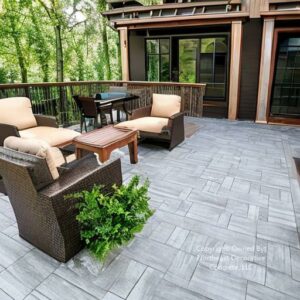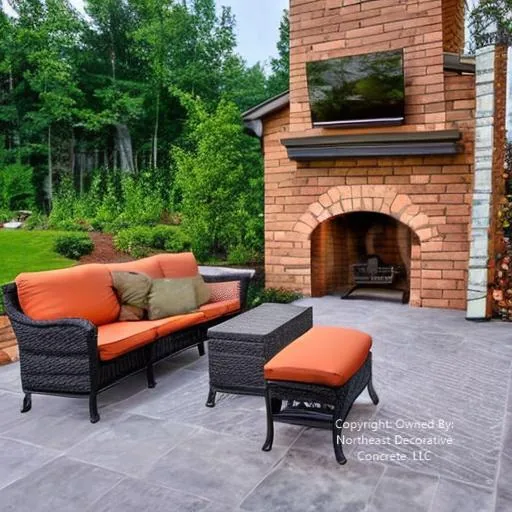
Are you considering installing a stamped concrete patio in your home? This article will help you understand the pros and cons of a stamped concrete patio, so you can make an informed decision before investing.
What are the Pros and Cons of a Stamped Concrete Patio?
A stamped patio can be a great way to add a unique feature to your outdoor space, but it’s essential to understand the pros and cons before you invest. Stamped finishes are a popular choice for outdoor spaces and can add a beautiful and unique look to your yard. They are also long-lasting and can be an excellent investment for your home. However, you should be aware of some drawbacks to installing a decorative deck before making a decision. In this article, we’ll discuss the positive and negative aspects of a decorative surface so you can make an informed decision.
Pouring and stamping concrete is an excellent option for patios and walkways due to its many advantages. It offers a wide range of pattern and color choices, allowing you to create unique designs that would be difficult to achieve with other materials. Decorative concrete is also more affordable than natural stone, brick, or pavers and takes less time to install, meaning your backyard will be back in use sooner. Additionally, patterned colored concrete is highly durable and requires less maintenance.
However, there are a few drawbacks to consider. Matching colors can be complex if repairs are needed in the future, and depressions may form over time due to wear and tear. Sealing is also required every 3-5 years to maintain its appearance and durability.
Overall, stamped concrete is an excellent option with many benefits over its alternatives, such as per square foot affordability, design flexibility, longevity, low maintenance requirements, quick installation time, and high return on investment.
Design Options: What are The Options for Stamped Concrete Designs
Decorative concrete can be used to create a variety of attractive outdoor concrete designs, such as:
- Natural stone patterns such as slate, flagstone, and fieldstone
- Brick, cobblestone, and wood patterns
- Seamless stamps that add texture without distinct joint patterns
- Custom designs by combining different patterns in the field and borders or adding hand-coloring
- Any look through shaping, texturing, and coloring.

Pros of Stamped Concrete Patios: Durability
- Durability: Stamped concrete patios come with many benefits and are incredibly durable, easy to maintain, and can last decades with proper care and maintenance. Decorative concrete is made from a mixture of concrete and other materials, making it resistant to cracking, fading, and staining.
- Cost-Effective: Textured concrete decks are generally more cost-effective than natural stone or brick materials. The cost of the materials and installation are usually lower than other options.
- Variety of Designs: Colored concrete decks come in various designs and patterns, so you can easily find one that matches your style and taste. You can choose from a variety of colors and textures, as well as custom designs.
- Easy to Maintain: Textured concrete decks are easy to maintain and can be cleaned with a hose or pressure washer. You won’t have to worry about scrubbing or sealing like you would with other materials.
- Add Value To Your Property: Patios can increase the value of your home or business by at least 15 percent. Great for resale if you ever sell.
Cons of Stamped Concrete Driveways and Patios
- Limited Color Options: While there are a variety of colors and designs available for textured concrete surfaces, the color options are limited compared to other materials like cultured stone or brick.
- Hard to Repair: Textured finishes can be challenging to repair if cracked or damaged. You may have to replace the entire deck if the damage is extensive.
- Can be Slippery: Textured surfaces can be slippery when wet if not installed properly, so using a non-slip sealant is essential to ensure safety and room for error.

FAQs:
Q: How Long Does a Stamped Concrete Walkway or Patio Last?
A: Patterned textured patio finishes can last 25-plus years with proper care and maintenance.
Q: Is Stamped Concrete Patio Slippery When Wet?
A: Decorative surfaces can be slippery when wet, so using a non-slip sealant is vital to ensure safety.
Q: Can Stamped Concrete Patios Be Repaired?
A: Stamped concrete paver can be challenging to repair if cracked or damaged. You may have to replace the entire deck if the damage is extensive. Make sure when hiring a contractor they know what they are doing. There are many steps needed to properly install a patio that can last a lifetime without needing any repairs.
Q. What are The Disadvantages of Stamped Concrete?
A.
1. Initial cost: Decorative finishes are more expensive than plain concrete, and the price can significantly increase if the project is complex.
2. Maintenance: They require resealing with unique sealers that must be applied every three to five years to protect the surface from weathering and staining.
3. Color: The colors used in decorative surfaces can fade over time and may require periodic touch-ups and sealant.
4. Shrinking/Cracking: Concrete can crack and shrink over time if installed incorrectly or if the substrate is not properly prepared.
5. Slipperiness: When colored concrete is poured and it can become slippery when wet and may not be suitable for pool decks, walkways, and other areas that are prone to moisture. It is imperative to hire stamped concrete contractors that knows what they are doing and installs the proper non-slip resistance additives to provide a stress-free non-slip surface.
Q. Is Stamped Concrete Good For Patios?
A. Yes, although stamped concrete comes with many good qualities for your patio and is a good option to have. It is a durable and low-maintenance material that can be customized to give your deck the look of pavers or natural stone, or other brick materials. It is also an affordable option compared to other decking materials.
Q. What is Good and Bad about Stamped Concrete?
A.
Good:
- Stamped concrete for your patio is less money and is incredibly durable and long-lasting.
- It can be designed to replicate the look of stone, brick, wood, and other materials, offering various design possibilities.
- It can be tinted with various colors and finishes to give the desired look and feel.
- It is relatively easy to install and maintain.
- It can be installed quickly and inexpensively.
Bad:
- Pros and cons of stamped concrete slabs can be slippery when wet so better options may exist for areas with high foot traffic.
- It is not suitable for areas with extreme climates, as it can crack or become discolored in extreme temperatures.
- It can be difficult to repair if damaged, as it may be challenging to match the color and design of the existing concrete mix.
- It can be expensive to install, depending on the complexity of the design.
Using stamped concrete decks and walkways can be a great way to add a unique feature to your outdoor living space while adding value to your home, but it’s essential to understand the pros and cons before you invest. Installing stamped concrete is less money offering an affordable, durable, and cost-effective option, but have limited color options and can be challenging to repair if damaged. They can also be slippery when wet, so a non-slip sealant is vital to ensure safety. We hope this article has helped you understand the good and bad of a stamped surface so you can make an informed decision before investing.
Our Locations:
Nashua, NH
North Hampton, NH
Concord, NH

